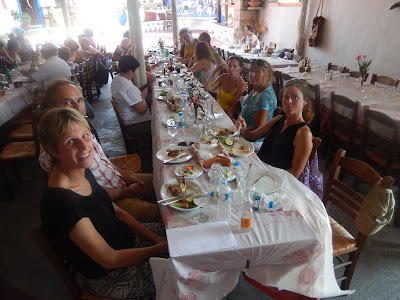by Alec Newell
 |
Monastery of St. John the Theologian - photo by Newell
|
 |
Entrance to the Cave of the Apocolypse
photo by Kristin Brodt |
Yesterday I made a day trip to the neighboring island of Patmos with Kristin Brodt, a friend just in from Florida. Patmos is just two hours south and west of Samos by ferry. A smaller, drier Island than Samos, its main claim to fame is that it is where the Book of Revelation was written by John the Apostle while in exile from Ephesus during a period of Christian persecution under the Roman Emperor Domitian (reigned: 81 to 96 ad).
John's eighteen month stay on Patmos is fairly well documented, and the island has become a destination for tourists and pilgrims who come there to visit the monastery built in 1088, and to see the cave where the Book of Revelation was written. There is a natural stone niche and writing stand in the cave where the book was dictated from God's lips to John's ears, and faithfully recorded:
 |
| photo by Newell |
Book of Revelation 1:11 - God to John the Apostle: I am Alpha and Omega, the first and the last: and, What thou seest, write in a book, and send it unto the seven churches which are in Asia; unto Ephesus, and unto Smyrna, and unto Pergamos, and unto Thyatira, and unto Sardis, and unto Philadelphia, and unto Laodicea.
|
|
Tour guided lunch at a large open air restaurant
photo by Newell
|
The monastery has miraculously escaped major looting over the centuries and still has a vast trove of important original icons, relics, and one of the best collections of Biblical manuscripts anywhere outside the Vatican. There is a manuscript that is believed to be the oldest extant copy of the Gospel according to Mark, and an original rendering of an icon by El Greco on display in the museum. The excursion took a full day and included a guided tour to the cave, museum, and monastery, a walking tour of Chora, a 16th Century community built just outside the monastery, lunch at a nice open air restaurant, and a guided bus tour of the south end of the island.
 |
The waiters who entertained us with traditional Greek dancing
photo by Newell |
The restaurant is a family operated business where the mother and uncles still do the cooking and the waiters are all brothers and nephews who dress in traditional garb and perform authentic Patmian dances for their guests. Patmos is a little off the beaten path for most tourists
and picture taking is not allowed inside the monastery church, the museum, or inside the Cave of the Apocalypse, but the experience is worth the trip if you have the time to visit the island.
 |
Sporty little convertible at the port of Skala, Patmos
photo by Newell
|











